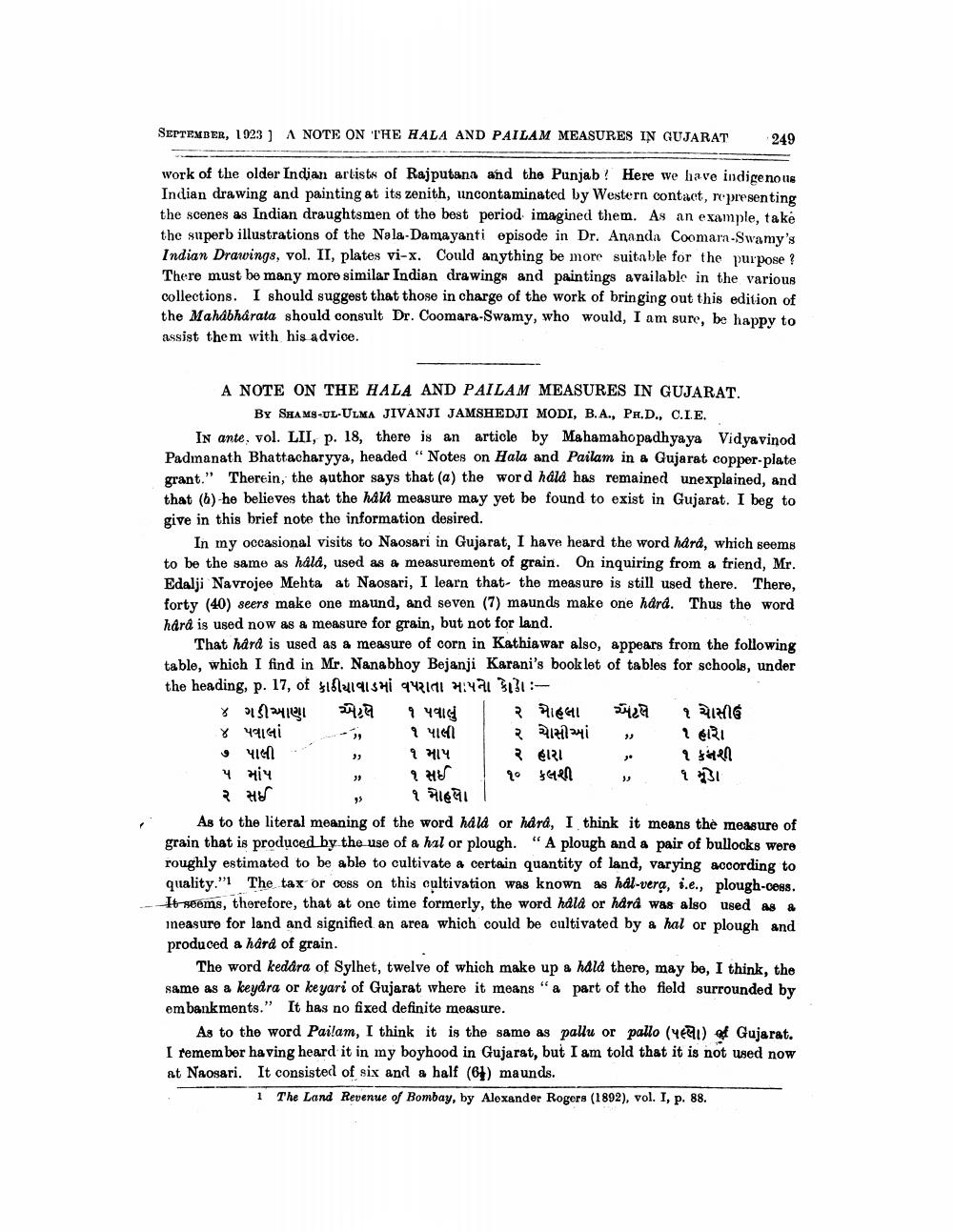________________
SEPTEMBER, 1923] A NOTE ON THE HALA AND PAILAM MEASURES IN GUJARAT
249
work of the older Indian artists of Rajputana and the Punjab! Here we have indigenous Indian drawing and painting at its zenith, uncontaminated by Western contact, representing the scenes as Indian draughtsmen of the best period imagined them. As an example, take the superb illustrations of the Nala-Damayanti episode in Dr. Ananda Coomara-Swamy's Indian Drawings, vol. II, plates vi-x. Could anything be more suitable for the purpose ? There must be many more similar Indian drawings and paintings available in the various collections. I should suggest that those in charge of the work of bringing out this edition of the Mahabharata should consult Dr. Coomara-Swamy, who would, I am sure, be happy to assist them with his advice.
A NOTE ON THE HALA AND PAILAM MEASURES IN GUJARAT.
BY SHAMS-UL-ULMA JIVANJI JAMSHEDJI MODI, B.A., PR.D., C.I.E. In ante, vol. LII, p. 18, there is an article by Mahamahopadhyaya Vidyavinod Padmanath Bhattacharyya, headed "Notes on Hala and Pailam in & Gujarat copper-plate grant." Therein, the author says that (a) the word håld has remained unexplained, and that (b)-he believes that the hal measure may yet be found to exist in Gujarat. I beg to give in this brief note the information desired.
In my occasional visits to Naosari in Gujarat, I have heard the word hard, which seems to be the same as hala, used as a measurement of grain. On inquiring from a friend, Mr. Edalji Navrojee Mehta at Naosari, I learn that- the measure is still used there. There, forty (40) seers make one maund, and seven (7) maunds make one hard. Thus the word hard is used now as a measure for grain, but not for land.
That hård is used as a measure of corn in Kathiawar also, appears from the following table, which I find in Mr. Nanabhoy Bejanji Karani's book let of tables for schools, under the heading, p. 17, of $1812191541 442191 4:4913131
૪ ગડીઆણું એટલે ૧ પવાલું ૨ મિહલા એટલે ૧ એસીઉં ૪ પવાલાં - ૧ પાલી | ૨ ચાસીઓ
૧ હારે. YA » 1714 26121
1394 ૫ માં"
» HS go $44e1 » 1331 ૨ સઈ
41841 As to the literal meaning of the word hala or hard, I think it means the measure of grain that is produced by the use of a hal or plough." A plough and a pair of bullocks were roughly estimated to be able to cultivate a certain quantity of land, varying according to quality." The tax or coss on this cultivation was known as hál-vera, i.e., plough-cess. It seems, therefore, that at one time formerly, the word hala or hård was also used as a ineasure for land and signified an area which could be cultivated by a hal or plough and produced a hârd of grain.
The word keddra of Sylhet, twelve of which make up a hala there, may be, I think, the same as a keyara or keyari of Gujarat where it means "a part of the field surrounded by embankments." It has no fixed definite measure.
As to the word Pailam, I think it is the same as pallu or pallo (MEI) of Gujarat. I remember having heard it in my boyhood in Gujarat, but I am told that it is not used now at Naosari. It consisted of six and a half (6) maunds.
1 The Land Revenue of Bombay, by Alexander Rogers (1892), vol. I, p. 88.




